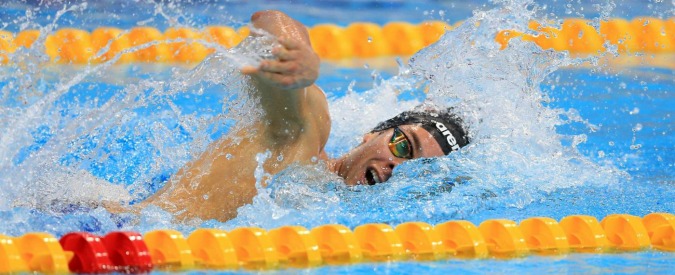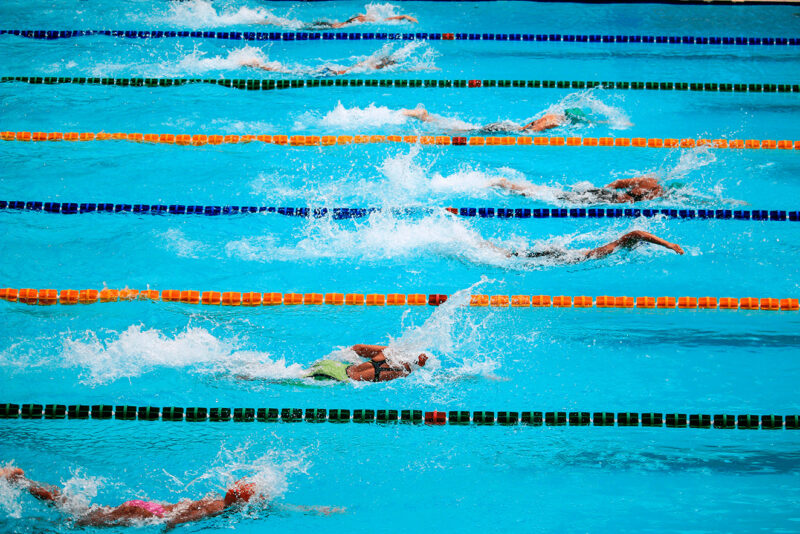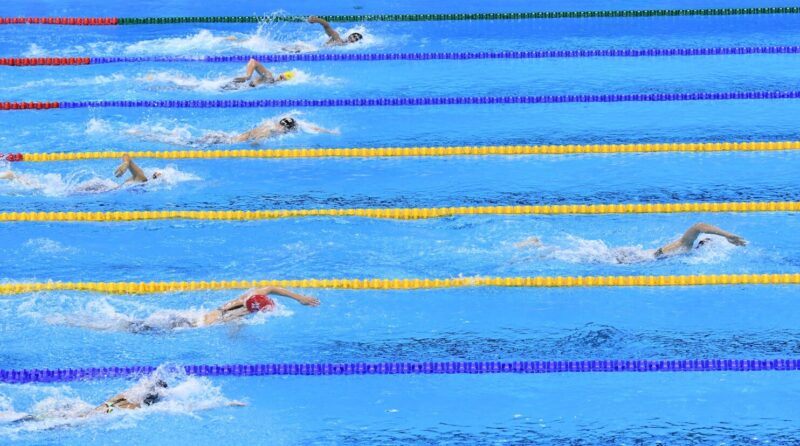Introduction
Pacing is defined as the energy distribution by which athletes should manage their effort during a competition (Abbiss & Laursen, 2008). Therefore, pacing could be an essential factor in endurance events, where athletes generally adopt an evenly pace during most of the race and increase their performance in the last meters of the competition (Thiel, Foster, Banzer, & De Koning, 2012).
In swimming, the 800 and 1500-m freestyle events are used to analize pacing due to the large number of splits and times performed by elite swimmers (Lipińska, Allen, & Hopkins, 2016a), although it has also been studied in other distances like the 400-m freestyle (Mauger, Neuloh, & Castle, 2012). Some studies has described the pacing strategy adopted by 800 and 1500-m swimmers, corresponding with a parabolic or U-shaped profile (Damasceno et al., 2013).
In 800-m freestyle of female swimmers, it was shown that the pacing profile could be characterized with slope parameters and curvatures of quadratic values (Lipińska, Allen, & Hopkins, 2016b). To deepen into the 1500-m freestyle event, the aim of the study was to use statistical models to investigate the effects of pacing modifications on the performance of 1500-m swimmers.

Methodology
To know the pacing strategies, the 50-m laps and the 1500-m total times were analyzed for swimmers in national and international competitions. All laps and time data were collected from various public domain web pages. 330 events were selected from 24 male swimmers (26.5 ± 3.7 years), placed in the top 40 of the FINA ranking between 2000 and 2014 with a minimum of six events performed per swimmer.
Pacing of each event was characterized with seven parameters derived from a general linear model: linear and quadratic coefficients for the effect of the laps number; reductions in the predicted time for the first, second, penultimate and last laps; and the variability of lap times. Scatter plots of race time against each parameter performed by each swimmer were used to identify optimal pacing values. Standard deviations and effects were transformed into percentage units.
The random effects variations were combined to assess the standard deviation between swimmers in all competitions and to estimate the intraclass correlation coefficients (ICC). The mean of the pacing parameters and the 10-year trend was assessed by non-clinical inference based on magnitude (Hopkins, Marshall, Batterham, & Hanin, 2009).

Results and discussion
The mean values of the linear and quadratic coefficients represented a small linear reduction in pacing. The average times for the first, second, penultimate and last laps were shorter than the time predicted by the quadratic profile of each swimmer. The percentage improvements in these laps were not coincide with the percentage improvement in race time, so the improvement in time had to be achieved in the 26 intermediate laps where swimmers adopted a gradual decrease in performance (Lipińska et al., 2016a).
Time reductions in the first lap were probably caused by the start and the underwater undulatory swimming. Likewise, the second lap was also faster due to the contribution of the faster swimming speed of the first lap (Lipińska et al., 2016a). The penultimate and last lap were also faster, presenting an increase in performance that takes place in the final meters of endurance races (Abbiss & Laursen, 2008). This pacing strategy corresponded to a parabolic profile, as already observed in previous studies in 800 and 1500-m swimmers (Damasceno et al., 2013; Skorski, Faude, Caviezel, & Meyer, 2014).
Variations between swimmers (1%) regarding to race time was similar to that analyzed in other studies with Olympic swimmers (Allen, Vandenbogaerde, & Hopkins, 2014). There was a large improvement of the performance trend in the 1500-m over the decade (2.1%), with small reductions in the second lap time and lap-to-lap variability. The trend was also described in 800-m female swimmers, where was obtained a gradual improvement less in ten years (1.1%). These estimated trends should not be compared to individual improvements, which can be much higher for 1500-m swimmers (3.2% in 5 years) (Costa et al., 2010).
Applications for coaches:
Optimal pacing values suggested reducing speed on the first or second lap, increasing it on the penultimate or last lap, or reducing lap-to-lap variability, which could lead to an improvement in the time of the 1500-m event. This method could be useful to help improve performance in endurance sports with multiple laps, controlling the pacing from the start to the end of the competition.
Extended version of the study
Lipińska, P., Allen, S. V., & Hopkins, W. G. (2016). Relationships between pacing parameters and performance of elite male 1500-m swimmers. International Journal of Sports Physiology and Performance, 11(2), 159-163. http://dx.doi.org/10.1123/ijspp.2015-0117
References
Abbiss, C. R., & Laursen, P. B. (2008). Describing and understanding pacing strategies during athletic competition. Sports Medicine, 38(3), 239-252.
Allen, S. V., Vandenbogaerde, T. J., & Hopkins, W. G. (2014). Career performance trajectories of Olympic swimmers: Benchmarks for talent development. European Journal of Sport Science, 14(7), 643-651.
Costa, M. J., Marinho, D. A., Reis, V. M., Silva, A. J., Marques, M. C., Bragada, J. A., & Barbosa, T. M. (2010). Tracking the performance of world-ranked swimmers. Journal of Sports Science & Medicine, 9(3), 411.
Damasceno, M., Correia-Oliveira, C. R., Narita, T., Pasqua, L., Bueno, S., Lima-Silva, A. E., & Bertuzzi, R. (2013). Pacing strategy adopted in crawl swimming competitions: An analysis of the 800-m and 1500-m distances. Revista Brasileira de Cineantropometria & Desempenho Humano, 15, 361–370.
Hopkins, W,G,, Marshall, S.W., Batterham, A.M., Hanin, J. (2009) Progressive statistics for studies in sports medicine and exercise science. Medicine Science and Sports Exercise, 41(1), 3–13.
Lipińska, P., Allen, S. V., & Hopkins, W. G. (2016a). Relationships between pacing parameters and performance of elite male 1500-m swimmers. International Journal of Sports Physiology and Performance, 11(2), 159-163.
Lipińska, P., Allen, S. V., & Hopkins, W. G. (2016b). Modeling parameters that characterize pacing of elite female 800-m freestyle swimmers. European Journal of Sport Science, 16(3), 287-292.
Mauger, A. R., Neuloh, J., & Castle, P. C. (2012). Analysis of pacing strategy selection in elite 400-m freestyle swimming. Medicine and Science in Sports and Exercise, 44(11), 2205-2212.
Skorski, S., Faude, O., Caviezel, S., & Meyer, T. (2014). Reproducibility of competition pacing profiles in elite swimmers. International Journal of Sports Physiology and Performance, 9(2), 217–225.
Thiel, C., Foster, C., Banzer, W., & De Koning, J. (2012). Pacing in Olympic track races: Competitive tactics versus best performance strategy. Journal of Sports Sciences, 30, 1107– 1115.

Leave a Reply